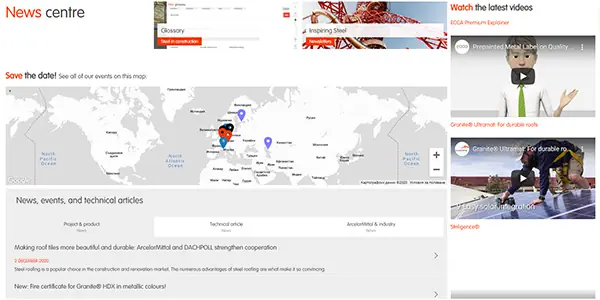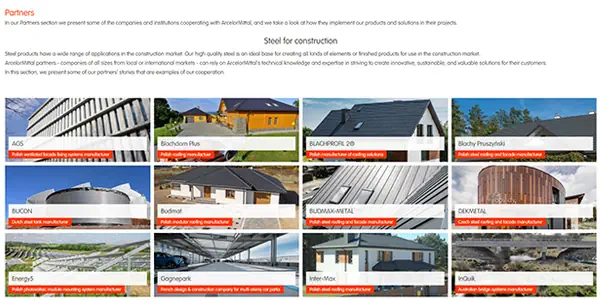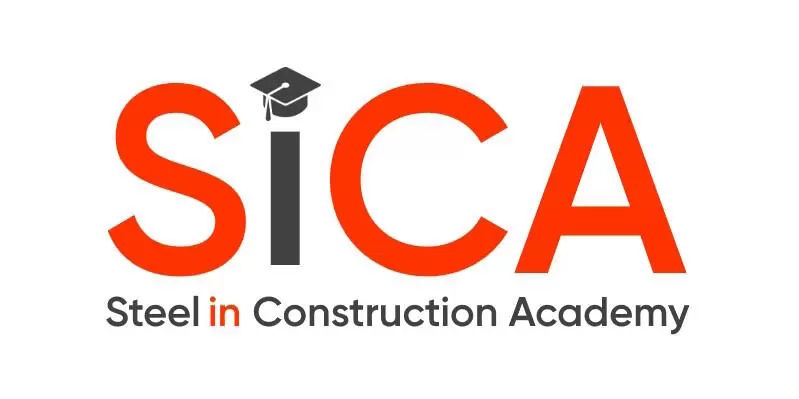Steel in Construction Academy
Drodzy Czytelnicy,
Z wielką przyjemnością przedstawiamy SiCA: Steel in Construction Academy, naszą najnowszą funkcjonalność, dostępną za darmo na platformie cyfrowej Constructalia.
Prawie 30 lat temu konsorcjum ponad 200 europejskich specjalistów w dziedzinie stali i konstrukcji stalowych, w tym ArcelorMittal, połączyło siły, aby wdrożyć program szkoleniowy ESDEP (European Steel Design Education Programme) mający na celu dalszy rozwój wykorzystania stali w budownictwie. Trzy lata temu postanowiliśmy wykorzystać całą tę zawartość, zweryfikować ją, zaktualizować i wzbogacić.
Szczególną uwagę zwróciliśmy na aktualizację zgodnie z obowiązującymi normami i przepisami, a zwłaszcza na zgodność z najnowszymi wersjami Eurokodów. Uwzględniliśmy również nowe produkty i rozwiązania dostępne na naszej stronie.
Niektóre tematy, takie jak zrównoważone budownictwo z wykorzystaniem stali, efektywność energetyczna i gospodarka cyrkulacyjna, które nie były brane pod uwagę podczas tworzenia treści, będą przedmiotem nowych publikacji.
Życzymy miłej lektury,
Patrick Le Pense
Building skin & Civil engineering segment manager
ArcelorMittal Europe - Flat Products
Introduction to steel's role in construction in Europe
Read LectureProcess of design
Read LectureDesign philosophies
Read LectureLimit state design and partial safety factors
Read LectureBackground to loadings
Read LectureHistorical development of iron and steel in structures
Read LectureHistorical development of steelwork design
Read LectureHistorical development of iron and steel in buildings
Read LectureHistorical development of iron and steel in bridges 1770-1970
Read LectureRe-use of existing buildings
Read LectureResidual life assessment for bridges
Read LectureAppendix to “Residual life assessment for bridges" lecture
Read LectureConcept and basis of steel metallurgy
Read LectureManufacturing and forming processes
Read LectureMechanical properties of steel
Read LectureToughness and resistance to brittle fracture
Read LectureSteel grades and qualities
Read LectureConcepts of stable and unstable elastic equilibrium
Read LectureGeneral criteria for elastic stability
Read LectureElastic instability modes
Read LectureGeneral methods for assessing critical loads
Read LectureIterative methods for solving stability problems
Read LectureBuckling of real structural elements I
Read LectureBuckling of real structural elements II
Read LectureMethods of analysis of steel structures
Read LectureCross-section classification
Read LectureLocal buckling
Read LectureTension members I
Read LectureBuckling lengths
Read LectureRestrained beams part 1
Read LectureFrames
Read LectureTrusses and lattice girders
Read LectureIntroduction to plate behaviour and design
Read LectureBehaviour and design of unstiffened plates
Read LectureBehaviour and design of stiffened plates
Read LecturePlate girder behaviour and design part 1
Read LecturePlate girder behaviour and design part 2
Read LecturePlate girder design - detailed design
Read LectureDesign of box girders
Read LectureAdvanced design of box girders
Read LectureIntroduction to shell structures
Read LectureBasic analysis of shell structures
Read LectureConnections in buildings
Read LectureIntroduction to connection design
Read LectureGeneralities on welded connections
Read LectureWelded connections - Basis for weld calculation
Read LectureWelded connections - Applications of fillet weld calculation
Read LectureIntroduction to corrosion process
Read LectureFactors governing protection of steelwork
Read LectureCorrosion protection for steel structures in buildings
Read LectureCorrosion protection of bridges
Read LectureIntroduction to fire safety
Read LectureBackground to thermal analysis
Read LectureBackground to structural (mechanical fire) analysis
Read LecturePractical ways of achieving fire resistance of steel structures
Read LectureIntroduction to fatigue
Read LectureWeldability of structural steels
Read LectureAdvanced introduction to fatigue
Read LecturePrinciples of welding
Read LectureThin-walled members and sheeting
Read LectureDesign procedures for cold-formed columns
Read LectureDesign procedures for cold-formed beams
Read LectureDiaphragm effect - stressed skin design
Read LectureApplication of thin-walled construction
Read LectureComposite construction - general
Read LectureBehaviour of beams
Read LectureSingle span composite beams
Read LectureComposite deck
Read LectureContinuous composite beams I
Read LectureContinuous composite beams II
Read LectureComposite beams - Design for serviceability part 1
Read LectureComposite beams - Design for serviceability part 2
Read LectureComposite beams - Shear connection part 1
Read LectureComposite beams - Shear connection part 2
Read LectureComposite beams - Shear connection part 3
Read LectureComposite columns part 1
Read LectureComposite columns part 2
Read LectureComposite building structures
Read LectureApplication of hollow sections in steel structures
Read LectureIntroduction to the design of simple industrial buildings
Read LectureIntroduction to the design of special industrial buildings
Read LectureIntroduction to the design of multi-storey buildings: part 1
Read LectureIntroduction to the design of multi-storey buildings: part 2
Read LectureConceptual choice
Read LectureThe design of steel and composite bridges: part 1
Read LectureThe design of steel and composite bridges: part 2
Read LecturePodziękowania
SiCA jest wynikiem pracy zespołowej i zaangażowania:
- Członków zespołu Constructalia, którzy przez prawie 3 lata, a w szczególności przez ostatnie kilka miesięcy, pracowali nad przygotowaniem wszystkich publikacji: Marty Dziarnowskiej, Joanny Parzyszek, Kathrin Sulzer i Jenny Blake. Zespół nadal będzie pracować nad wzbogacaniem treści.
- Naszego partnera – firmy Aware, a w szczególności Thomasa Vermeiren i Stijna Cuylle, którzy opracowali nowe funkcje dla platformy Constructalia,
- Kolegów z ArcelorMittal Europe - Flat Products: Corinne Dieu, François Blanchet i Patrick Pol, którzy pomogli zrewidować niektóre treści,
- Dr inż. Wiolety Barcewicz, prof. uczelni Politechnika Warszawska, która kontynuuje weryfikację i aktualizację wielu wykładów, szczególnie tych związanych z Eurokodami,
- Carola Farinaud, konsultanta, który pomagał nam przy projekcie renowacji Constructalii.
Chciałbym podziękować wszystkim za ich zaangażowanie i pracę.
Patrick Le Pense
Szczególne podziękowania
Chcielibyśmy podziękować Patrickowi Le Pense. Bez jego doświadczenia, konsultacji i doradztwa powstanie projektu SiCA nie byłoby możliwe a zawartość nigdy nie zostałaby opublikowana.
Zespół Constructalia
Zastrzeżenia
Pomimo dołożenia wszelkich starań przy sprawdzaniu treści i formatowaniu, istnieje prawdopodobieństwo, że niektóre nieaktualności zostały przeoczone. Prosimy o zgłaszanie ich do nas na adres: constructalia(at)arcelormittal.com
Treść tych wykładów ułatwia naukę, ale w żadnym wypadku nie powinna być wykorzystywana do ostatecznego projektowania i obliczania.
Treści te mogą być wykorzystywane nieodpłatnie. Użytkownikowi nie przysługują żadne prawa do treści, których własność i prawa intelektualne nadal należą do firmy ArcelorMittal. Użytkownikowi nie udziela się żadnej gwarancji.
Grupa ArcelorMittal nie ponosi odpowiedzialności za jakiekolwiek straty lub szkody poniesione bezpośrednio i/lub pośrednio w wyniku korzystania z tych treści. Użytkownik zobowiązuje się zwolnić firmę ArcelorMittal z odpowiedzialności z tytułu wszelkich roszczeń oraz szkód bezpośrednich, pośrednich i/lub wtórnych, w szczególności wynikających z nieprawidłowego lub nieodpowiedniego wykorzystania lub wykorzystania treści w nieodpowiednim lub niewłaściwym celu.






















